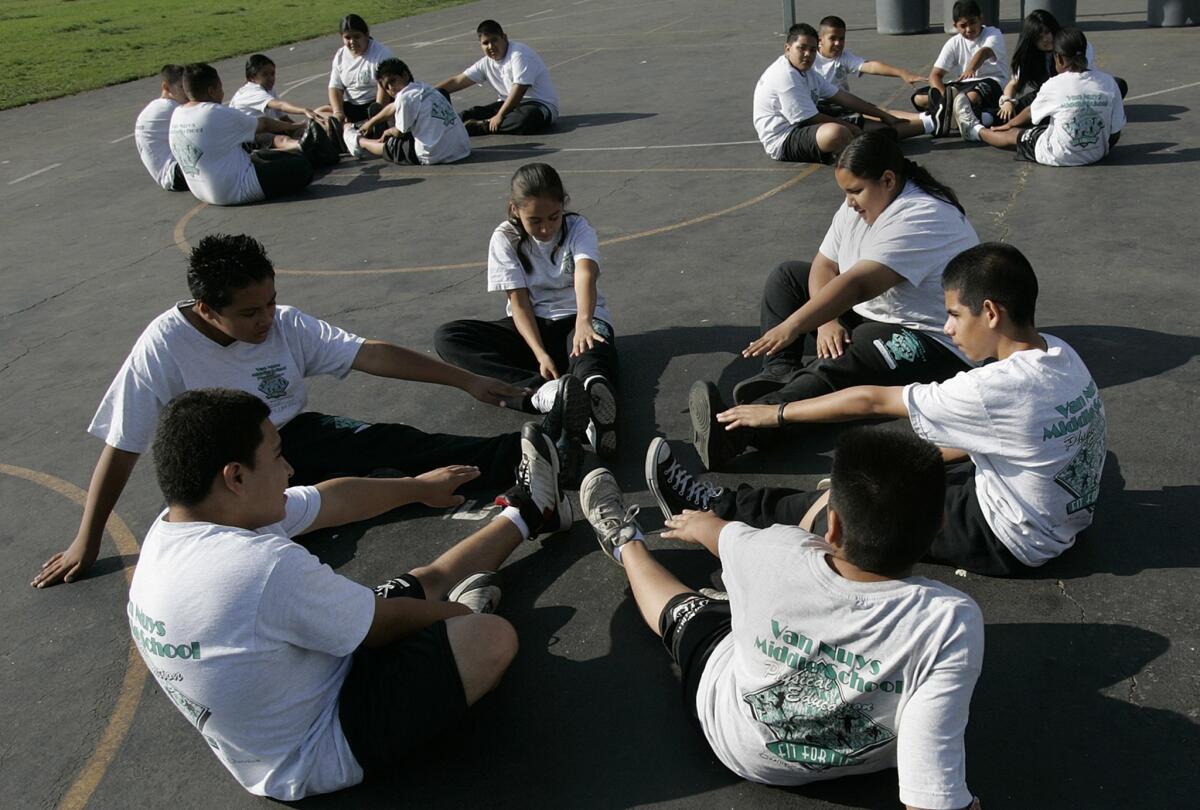California schools face lawsuit over physical education classes

Thousands of elementary school teachers have been asked this summer to hold on to their lesson plans as 37 school districts throughout the state seek to show that they are providing students with required exercise.
A lawsuit was filed in October in San Francisco County Superior Court on behalf of plaintiffs Marc Babin, a parent, and Cal200, an organization he heads that advocates for elementary school physical education. Babin’s children, now adults, went to school in the Alameda Unified School District, one of the defending districts, according to his Albany, Calif., attorney, Donald Driscoll.
“School districts have been routinely ignoring the law,” Driscoll said. And the Los Angeles Unified School District, the state’s largest, “has been a particular offender. They give lip service to the idea that P.E. is important. That just plain doesn’t work. What that produces is kids who don’t get enough exercise.”
L.A. Unified, along with Palm Springs Unified and others, have asked teachers to show that they are meeting state requirements for physical education. The lesson plans typically outline schedules for instruction, activities and classes.
In addition to lunch and recess, schools must offer kindergarten through sixth-grade students 200 minutes of physical education instruction for every 10 days of class, as required in the state Education Code.
The teacher records could be compared to the information that school administrators previously submitted to the California Department of Education to verify the number of hours students had P.E., Driscoll said.
According to court documents, L.A. Unified determined the complaint had merit, but that the “allegations have already been rectified.”
Chad Fenwick, a former P.E. teacher at Patrick Henry Middle School in Granada Hills, said he’s seen L.A. Unified make great strides in improving programs since he became the district advisor for elementary physical education in 2004.
Quality varied widely across schools at the time, he said. In some cases, physical education was taught by school aides as opposed to credentialed teachers and not all met the 200-minute minimum. Some only offered what he called “glorified recess,” without formally training students to use proper fitness techniques.
“We’re an extremely large district, the second largest in the nation. To have everything perfect all at once, it takes time. We did have problems, but we’ve made huge gains,” Fenwick said. “It’s not an easy task. We’ve been taking a systematic approach and it’s working.”
Today, Fenwick said the district dedicates $1.7 million of its general fund to send 17 designated instructors to 84 different schools each year to better train classroom teachers. Schools are now accountable for posting their activity schedules online to ensure that both the proper quantity and quality of P.E. are administered.
In 2012, L.A. Unified’s obesity rate exceeded the national average, and while many middle and high schools met state P.E. standards, elementary classes had trouble keeping up, according to a study from the Sarah Samuels Center for Public Health Research & Evaluation based in Oakland.
Many families may feel it’s unsafe to play outside in their neighborhoods, so exercise at school is especially critical, said Mariah Lafleur, a senior analyst at the consulting firm and one of the study’s authors.
“It might be the only chance they have to be active in their day,” Lafleur said.
According to the report, there weren’t enough credentialed teachers dedicated to P.E. to serve students and not all classes encouraged them to be active enough to increase their heart rates.
“Schools just have many competing priorities,” Lafleur said. “But we think allotting the time for P.E. will, as a side benefit, improve students’ attention spans and behavior so they’re able to be well-balanced kids.”
District initiatives in healthy eating and fitness have helped whittle down obesity rates over time. L.A. Unified has been a leader in increasing healthy foods in school lunches, and eliminating flavored milk and soda. In 2005, 42.6% of its students were obese; the number steadily decreased to about 41.6% by 2010, according to data from the California Center for Public Health Advocacy.
Norwood Street Elementary School is one success story, boosting its fifth-graders’ body composition test pass rate from 30.7% in the 2010-2011 school year to 57.9% in the 2012-2013 school year.
“People are afraid if you take kids out of the classroom for P.E., they’ll lose academic time and their [test] scores will go down,” Fenwick said, “but the brain and the human body work more efficiently when you’re physically active and healthy.”
Twitter: @haydensaraa
More to Read
Sign up for Essential California
The most important California stories and recommendations in your inbox every morning.
You may occasionally receive promotional content from the Los Angeles Times.










